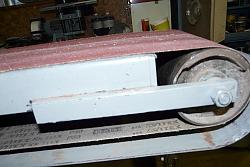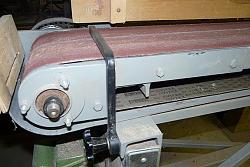Many years ago I built me a real belt sander. The bed is 4 ft. long and 8 in. wide. The motor is 1 1/2 HP 120 Volt. Actually this was the proto type of about a half dozen I built for others. As you can see you don't have to dis-assemble any thing to replace the belt. The controls are all on the back side. The yoke supporting the movable drum slides on a shaft and a bell crank pulls it in and out via a screw and knob. Also the tracking is controlled by a single screw and knob. Back in the mid 80s I built a spoon rack with a pendulum chime clock in the center of it for my wife who passed away in 86. I swore I would not build anything like that again unless I had a decent belt sander. With this sander I can true up the edge of a board, door, panel or anything else I need sanded square or true or flat. The fence is square to the belt and the vertical cleat is also square to the belt so I can sand the end of pieces by supporting them vertically. I have used up about a 1/2 dozen belts over the years. Most of them finally let go on the joint. By the way I also have graphite cloth cemented to the platen to reduce friction on the belt. I don't know what I would have done without it all the years as I am using constantly.
You may notice that I used only 3 legs which was OK but found the the stand seemed to have jellyness to it. It would jiggle when you hit the end on the side so I added braces until that was eliminated. Subsequent versions got 2 legs spaced about 6" apart on the end and only 2 braces which solved that problem. They also received a 12 in. disc on the back side with a tilting table. Machine sits on 3 casters so it can be rolled around out of the way.
By setting the fence at an angle I can feed long boards across it and it will sort of self feed by controlling the speed it pulls on the board.
Nick




 LinkBack URL
LinkBack URL About LinkBacks
About LinkBacks


 Reply With Quote
Reply With Quote












Bookmarks